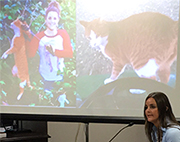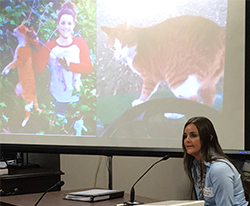

VIN News Service photo
During a hearing in April, Dr. Kristen Lindsey addressed a side-by-side comparison of the cat she killed and her neighbor's missing tabby, Tiger. While she testified that the photos do not depict the same cat, the administrative law judges presiding over her appeal disagreed.
Dr. Kristen Lindsey's license should be suspended for a year and probated for four more, on condition that she complete courses on animal cruelty and spend at least 100 hours volunteering at a feline rescue or similar facility.
That's the recommendation of administrative law judges Catherine Egan and Pratibha Shenoy, who issued findings Monday concerning Lindsey's case. The 32-year-old veterinarian has attracted public and professional scrutiny since April 15, 2015, when she used a bow-and-arrow to kill a cat in the backyard of her home in Brenham, Texas.
She later posed with the body for a Facebook photo, captioned: “My first bow kill... lol. The only good feral tomcat is one with an arrow through its head. Vet of the year award ... gladly accepted.”
Lindsey faces animal cruelty charges levied by state regulators even though a grand jury declined in June 2015 to indict her, citing a lack of evidence. Texas law permits citizens to kill non-livestock animals on their property if the animals pose a threat or are being destructive, and Lindsey stated that the cat she shot had been tearing into feed bags, repeatedly urinated on her porch and harassed her own cat.
Regulators, however, determined that a criminal conviction wasn’t needed to bring charges of animal cruelty as a violation of administrative law. In October, the Texas Board of Veterinary Medical Examiners filed a formal complaint with the State Office of Administrative Hearings, asking to revoke Lindsey's license. The gravity of Lindsey's case was compounded by allegations that the cat she killed wasn't a stray but her neighbor's beloved orange tabby, Tiger.
Maggie Griffith, the board's general counsel, explained the charges against Lindsey this way: “The specific board rule that we’re alleging she violated is adherence to the law. We're trying to show that her conduct had an element of criminal intent. We proceeded under an animal cruelty criminal offense."
Ethics charges also were raised against Lindsey, whose defense was that in Texas, the killing of feral cats is generally accepted conduct.
Lindsey appealed the TBVME's complaint, which resulted in a two-day administrative hearing that ended April 26 in Austin, Texas.
Egan and Shenoy's recommendations are a result of that hearing. The final decision is up to TBVME members who will reconsider Lindsey's case in light of the judges' findings. The earliest the TBVME might address the case is during its next meeting on Oct. 18, Griffith said.
Predicting an unfavorable outcome for Lindsey, her attorney Brian Bishop said he will appeal the board's decision to Travis County District Court.
“We respectfully disagree with a number of the ALJ's findings,” he said by email.
In support of their recommendation, the administrative law judges had harsh words for Lindsey's conduct, characterizing it as "reckless" and finding that she was not, as she had testified, acting in self-defense or protecting her pets when shot the cat. They stated that Lindsey acted within the “guise” of the practice of veterinary medicine when she identified herself as a veterinarian in her Facebook post that boasted about the kill.
What's more, the cat was not a stray, the judges stated, contradicting Lindsey's assertions that the cat she killed was sexually intact and therefore couldn't be the neighbor's pet, who was neutered. A grainy photo of the body generated heated debate during the administrative hearing, with Lindsey insisting that the carcass showed a scrotal sac. Dr. William Folger, a board-certified feline practitioner and expert witness for the state, disagreed. He also compared Lindsey’s Facebook photo of the deceased cat to a photo of Tiger, finding that markings on the coats matched.
Egan and Shenoy said that was the “most relevant and reliable evidence of the cat’s identify.”
“Dr. Folger convincingly testified, the physical patterns on the fur of both cats are strikingly similar,” the recommendation said. “Although orange tabby cats are common cats … the ALJs are persuaded that the cat was Tiger…”
The cat's identity matters because the animal cruelty charge only sticks if its proven that the act occurred without the owner's consent. The judges agreed with state regulators that Lindsey violated the veterinary board’s rules of professional conduct.
However, her actions are mitigated by the fact that the cat died instantaneously, and Tiger’s owners expressed a desire that Lindsey learn from her actions rather than lose her license, the recommendation said. The judges pointed out that Lindsey has no prior history of trouble with the board and poses a low risk to public health and safety.
They also referenced an attitude in some rural communities that it’s necessary to kill feral cats and stated that the veterinary profession is split on how to treat feral cat populations.
"The ALJs are persuaded by a preponderance of evidence that the cat at issue in this case was Tiger, not a feral cat," the recommendation said. "However, (Lindsey) believed she was shooting a feral cat, and there is no settled understanding in the veterinary profession of 'the conduct that is expected of a veterinarian' with respect to the treatment of feral cat populations. Veterinarians disagree about whether graduate reduction of feral cat populations through (trap-neuter-release) is possible, or whether the harm caused by feral cats requires more aggressive intervention through euthanasia."
Lindsey's license to practice veterinary medicine in Texas remains valid while her case is being decided.